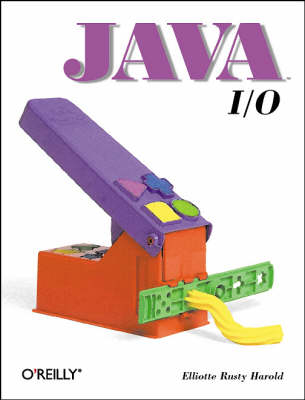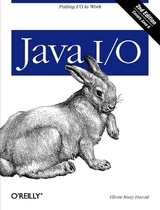
Java I/O
O'Reilly Media (Verlag)
978-1-56592-485-7 (ISBN)
- Titel erscheint in neuer Auflage
- Artikel merken
All of Java's Input/Output (I/O) facilities are based on streams, which provide simple ways to read and write data of different types. Java provides many different kinds of streams, each with its own application. The universe of streams is divided into four large categories: input streams and output streams, for reading and writing binary data; and readers and writers, for reading and writing textual (character) data. You're almost certainly familiar with the basic kinds of streams -- but did you know that there's a CipherInputStream for reading encrypted data? And a ZipOutputStream for automatically compressing data? Do you know how to use buffered streams effectively to make your I/O operations more efficient? Java I/O tells you all you ever need to know about streams -- and probably more. A discussion of I/O wouldn't be complete without treatment of character sets and formatting. Java supports the UNICODE standard, which provides definitions for the character sets of most written languages. Consequently, Java is the first programming language that lets you do I/O in virtually any language. Java also provides a sophisticated model for formatting textual and numeric data.
Java I/O shows you how to control number formatting, use characters aside from the standard (but outdated) ASCII character set, and get a head start on writing truly multilingual software. Java I/O includes: Coverage of all I/O classes and related classes In-depth coverage of Java's number formatting facilities and its support for International character sets
Elliotte Rusty Harold is a noted writer and programmer, both on and off the Internet. He started by writing FAQ lists for the Macintosh newsgroups on Usenet, and has since branched out into books, Web sites, and newsletters. He's currently fascinated by Java, which is beginning to consume his life. His Cafe Au Lait Web site at http://sunsite.unc.edu/javafaq/ is one of the most popular independent Java sites on the Net. Elliotte resides in New York City with his wife Beth and cats Charm (named after the quark) and Marjorie (named after his mother-in-law). When not writing about Java, he enjoys genealogy, mathematics, and quantum mechanics, and has been known to try to incorporate these subjects into his computer books (when he can slip them past his editors). So far he hasn't been able to, but he suspects that a short, last-minute biography might not be inspected as closely as the rest of a manuscript. His other books include The Java Developer's Resource (Prentice Hall), Java Network Programming (O'Reilly), Java Secrets (IDG Books), and JavaBeans (IDG Books)
Preface. I. Basic I/O. 1. Introducing I/O What Is a Stream? Numeric Data Character Data Readers and Writers The Ubiquitous IOException The Console: System.out, System.in, and System.err Security Checks on I/O. 2. Output Streams The OutputStream Class Writing Bytes to Output Streams Writing Arrays of Bytes Flushing and Closing Output Streams Subclassing OutputStream A Graphical User Interface for Output Streams. 3. Input Streams The InputStream Class The read( ) Method Reading Chunks of Data from a Stream Counting the Available Bytes Skipping Bytes Closing Input Streams Marking and Resetting Subclassing InputStream An Efficient Stream Copier II. Data Sources. 4. File Streams Reading Files Writing Files File Viewer, Part 1. 5. Network Streams URLs URL Connections Sockets Server Sockets URLViewer III. Filter Streams. 6. Filter Streams The Filter Stream Classes The Filter Stream Subclasses Buffered Streams PushbackInputStream Print Streams Multitarget Output Streams File Viewer, Part 2. 7. Data Streams The Data Stream Classes Reading and Writing Integers Reading and Writing Floating-Point Numbers Reading and Writing Booleans Reading Byte Arrays Reading and Writing Text Miscellaneous Methods Reading and Writing Little-Endian Numbers Thread Safety File Viewer, Part 3. 8. Streams in Memory Sequence Input Streams Byte Array Streams Communicating Between Threads with Piped Streams. 9. Compressing Streams Inflaters and Deflaters Compressing and Decompressing Streams Working with Zip Files Checksums JAR Files File Viewer, Part 4. 10. Cryptographic Streams #Function Basics The MessageDigest Class Digest Streams Encryption Basics The Cipher Class Cipher Streams File Viewer, Part 5 IV. Advanced and Miscellaneous Topics. 11. Object Serialization Reading and Writing Objects Object Streams How Object Serialization Works Performance The Serializable Interface The ObjectInput and ObjectOutput Interfaces Versioning Customizing the Serialization Format Resolving Classes Resolving Objects Validation Sealed Objects. 12. Working with Files Understanding Files Directories and Paths The File Class Filename Filters File Filters File Descriptors Random-Access Files General Techniques for Cross-Platform File Access Code. 13. File Dialogs and Choosers File Dialogs JFileChooser File Viewer, Part 6. 14. Multilingual Character Sets and Unicode Unicode Displaying Unicode Text Unicode Escapes UTF-8 The char Data Type Other Encodings Converting Between Byte Arrays and Strings. 15. Readers and Writers The java.io.Writer Class The OutputStreamWriter Class The java.io.Reader Class The InputStreamReader Class Character Array Readers and Writers String Readers and Writers Reading and Writing Files Buffered Readers and Writers Print Writers Piped Readers and Writers Filtered Readers and Writers File Viewer Finis. 16. Formatted I/O with java.text The Old Way Choosing a Locale Number Formats Specifying Width with FieldPosition Parsing Input Decimal Formats An Exponential Number Format. 17. The Java Communications API The Architecture of the Java Communications API Identifying Ports Communicating with a Device on a Port Serial Ports Parallel Ports V. Appendixes A. Additional Resources B. Character Sets
| Erscheint lt. Verlag | 20.4.1999 |
|---|---|
| Reihe/Serie | Java S. |
| Zusatzinfo | illustrations |
| Verlagsort | Sebastopol |
| Sprache | englisch |
| Maße | 175 x 232 mm |
| Gewicht | 850 g |
| Einbandart | kartoniert |
| Themenwelt | Informatik ► Programmiersprachen / -werkzeuge ► Java |
| Mathematik / Informatik ► Informatik ► Web / Internet | |
| ISBN-10 | 1-56592-485-1 / 1565924851 |
| ISBN-13 | 978-1-56592-485-7 / 9781565924857 |
| Zustand | Neuware |
| Haben Sie eine Frage zum Produkt? |
aus dem Bereich



